America The Beautiful Silver Coin Series
Although the new series of large, five ounce quarter dollar silver bullion coins produced by the U.S. Mint with a high-powered German coining press, might appear to be a good source of stored value thanks to their weight, they are more likely to be useful as a collectible investment. This is America’s first venture into a silver bullion coin larger than 1 troy ounce.
The distinctive designs that appear on the coin’s reverse, depicting both grand natural features and interesting human monuments of the North American continent’s most populous nation, will likely make these coins highly collectible as time goes by, and cause them to command a price well in excess of spot.
As usual, the U.S. Mint does not sell coins direct to the public, probably because of a lack of programmers experienced enough to make a web store like those found on the Australian and other Mint sites. Authorized dealers offer the bullion coins during the year when they are struck, and after that you need to rely on secondary sellers, such as the highly reliable American Precious Metals Exchange (APMEX).
Sets of 2 and sets of 5 America the Beautiful Silver Coins are offered, as well as tubes of 10 and 100 coins. Individual coins are also available from some sources, and of course these will become more readily available as time goes on.
Characteristics of the America the Beautiful Silver Coins
The America the Beautiful coins stand out from all previous U.S. Mint silver bullion coin issues because of their size. No other silver coin struck by the American government has ever been this large, making its release a historic moment for the Mint. Weighing in at five troy ounces, with a diameter of three inches (76 mm) and a thickness of 1/8 inch (3.25 mm), these coins are struck out of 99.9% pure silver (that is, they have a fineness of .999).
In what is an ironic statement on the meaninglessness of the face values which governments still inscribe on their silver bullion coins, the America the Beautiful coins are quarters – worth, at their nominal face value, 25 cents each. In all details, they are exceedingly overgrown quarters – while the Silver Eagle coins, five times smaller, have a nominal face value of $1!
Production of the series began in 2010 when the Mint acquired the new coining press noted above. The coins are released in batches of five annually, with the full run expected to last for a decade, so that one beautiful site from each of the nation’s fifty states is included in the series. Six additional coins will also be produced to cover natural or man-made landmarks found in the North Mariana Islands, Guam, American Samoa, the U.S. Virgin Islands, the District of Columbia, and Puerto Rico.
The first ten coins have already been released to the public, and can be bought individually or in sets of two or five, depending on which coins are being bought. The ten coins which have already been released are described in more detail here, while the rest can be learned about on various numismatic sites, the U.S. Mint webpage, and even online encyclopedias.
The obverse of every coin in the series is identical, featuring a profile effigy of the United States’ first president, George Washington, as depicted in 1932 by John Flanagan. The legends “United States of America”, “Liberty”, “In God We Trust”, and “Quarter Dollar” appear in various positions around the president’s image. The obverse shows something related to the chosen site, as well as indicating the state where it is located, the year, a one-word description of the site, and the words “E Pluribus Unum”.
Hot Springs National Park Coins (2010)
Hot Springs National Park is the theme of the America the Beautiful quarter released for Arkansas – an area of naturally occurring hot springs which have been used for bathing, drinking, and other health related activities for two centuries. The springs area is a park that can be hiked through by anyone, though access to the springs themselves is only available for a fee.
The park is noted for its Gilded Age architecture, which is featured on the coin – the facade of the headquarters building for Hot Springs National Park is shown, with a water fountain in front of it. The first coin of the series thus shows a building rather than a natural formation of some kind.
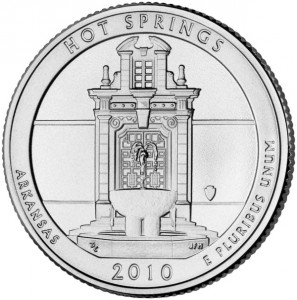
Yellowstone National Park Coins (2010)
The first year’s releases could not be complete without inclusion of America’s most famous national park, Yellowstone. This area of geysers, crags, grizzly bears, and bison is located in the mountain state of Wyoming, not far from where the famous Jeremiah Johnson and his friend Crazy Woman lived. The geothermal springs and animals found in the park are its chief claims to fame, and both are shown on the silver bullion coin.
An American bison stands four-square in the foreground, while the searing plume of Old Faithful rises behind him against a horizon of mountain peaks.
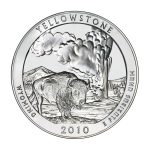
Yosemite National Park Coins (2010)
California’s Yosemite National Park is featured on the third coin, depicting what is probably the second most famous site after Yellowstone in the National Park system. Yosemite is noted for colossal granite cliffs, pine forests, and beautiful waterfalls, as well as stands of the enormous California redwood trees which one formed extensive forests in this west coast state.
The looming, three thousand foot granite monolith, El Capitan, is featured on the coin, with slender pines at its base and a hint of water in the foreground.

Grand Canyon National Park Coins (2010)
Determined to squeeze at least three of America’s most spectacular natural sites into the first year, the U.S. Mint placed the Grand Canyon National Park onto the fourth coin released, in this case for Arizona. This abyss-like canyon, eroded from the sandstone by the flow of water over millions of years, is one of the world’s largest and was first explored by a group of colorful, individualistic eccentrics during the mid nineteenth century, proving fatal to several of the adventurers.
The coin’s reverse shows part of Marble Canyon close to the Colorado River entrance, an area which is favored by those who want to launch their boats into the foaming waters at the canyon’s base.
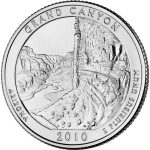
Mount Hood National Forest Coins (2010)
Mount Hood is a mostly dormant stratovolcano located in Oregon, famed for the exquisitely beautiful, shining mantle of snow which covers much of its soaring flanks, and which contrasts with the rich green of the surrounding forests. The national forest is a popular destination for campers and hikers, while Mount Hood itself is the second most popular mountain in the world for mountain-climbers.
The coin’s reverse shows an almost stylized view of the National Forest, with Mount Hood in the background, a stripe of tiny pine trees across the center of the coin, and the waters of Lost Lake in the foreground.
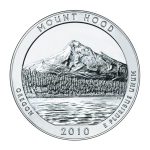
Gettysburg National Military Park Coins (2011)
The first release for 2011 was the Gettysburg National Military Park coin, representing a famous park in Pennsylvania. This park preserves the battlefield where the invading army of Robert E. Lee was defeated in an extremely bloody battle during three days at the start of July, 1863, shifting the Confederacy to the defensive and ultimately leading to a Union victory in the American Civil War.
The coin shows the pleasant, rolling countryside of the battlefield, with open fields and trees, behind a monument depicting a Union Zouave preparing to use his musket as a club, and part of a Civil War era cannon. This is the 72nd Pennsylvania Infantry Monument, commemorating the repulse of Ambrose Wright’s 3rd Georgia Infantry at the Angle as well as its supporting role during Pickett’s Charge.

Glacier National Park Coins (2011)
Located in Montana, Glacier National Park is an enormous ecosystem park which is one of the most important nature preserves in the nation, though it is fortunately less popular among throngs of tourists than Yellowstone or Yosemite. Glacier National Park represents one of the few remaining areas where the original wilderness of the United States has remained completely untouched and in the state it was in prior to European colonization.
This park is, in effect, a final fragment of the original flora and fauna of the country before the introduction of modern society. The water of its one hundred thirty lakes is some of the purest in the world, and grizzly bears, mountain goats, and other animals abound here.
The reverse of the Glacier America the Beautiful silver bullion coin shows a mountain goat perched on a high stance of rock, looking out over pine trees to the distant slopes of Mount Reynolds.
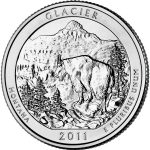
Olympic National Park Coins (2011)
Olympic National Park is the theme of the coin release due to be struck this year for Washington state, a large park which includes not only rugged Washington seashores but also temperate rain forest and glaciated mountain ranges. The park is popular for hiking and skiing, due to its notable views and slopes, but is most useful as a living, preserved ecosystem of the West Coast’s original ecology.
The coin shows an Olympic Elk – a species now found only in the park – poised on a gravel shoal in the Hoh River, against a backdrop of pines and the park’s Mount Olympus.
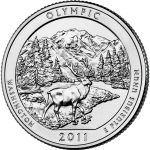
Vicksburg National Military Park Coins (2011)
Vicksburg National Military Park is the subject of Mississippi’s coin for the America the Beautiful Silver Bullion Coin series – a park with numerous walking trails, statues, Civil War artillery pieces, and so forth, in remembrance of the Battle of Vicksburg, during which Ulysses S. Grant captured Vicksburg itself and gained control of the strategically important Mississippi River for the Union. The park is unique in having statues of the two opposing presidents – Abraham Lincoln and Jefferson Davis – standing as if in conversation in a single monument.
The Vicksburg coin shows the U.S.S. Cairo, an ironclad gunboat with the dubious distinction of being the first vessel to sink after being struck by an electrically detonated mine. The Cairo was raised from the waters of the Yazoo River in 1964, with its armored top section currently on display at the park.
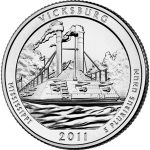
Chickasaw National Recreation Area Coins (2011)
The Chickasaw National Recreation Area is the last of the five America the Beautiful Silver Bullion Coins that will be released in 2011, and represents the state of Oklahoma. The National Recreation Area is a mix of forests, hills, and numerous streams, rivers, and small lakes which is extremely popular for relaxing water activities. Admission is free thanks to the Chickasaw tribe.
The Lincoln Bridge, a stone bridge built to honor the tall, lean sixteenth president of the United States, is shown on the coin, since it is located within the Recreation Area.
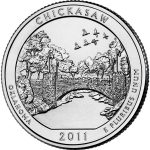
Future America the Beautiful Coins
The series is intended to continue annually until 2021, when it will terminate with the release of Alabama’s Tuskegee Airmen National Historic Site coin, assuming that no administration cancels the program in the meantime (which is highly unlikely, considering how popular – and thus profitable – the coin series is). Collectors from around the world can expect a high quality, well-struck series of five ounce coins to continue for at least another decade, celebrating the natural wonders and significant monuments of the United States.
History of the America the Beautiful Silver Bullion Coin Series
America the Beautiful Silver Bullion coins are coin series with a genesis in the natural wonders of the United States – which, despite its crowded cities stinking of gasoline and freeways howling with traffic, still boasts dozens of magnificent places. The continent is so huge that nearly every type of terrain imaginable is found in it, from the arctic tundra of northern Alaska to the southwestern deserts, from the great forests of the upper Midwest to the blue-misted mountains of Pennsylvania and New York State.
There are many scenes throughout the land of the Stars and Stripes which lend themselves to artistic representation. The geysers and wildlife of Yellowstone Park, found amid the rugged folds of the Rocky Mountains, are just one example, as are the vastness of the Great Lakes, the looming, seven-hundred fifty foot (230 meter) dunes of Great Sand Dunes National Park, which were formed while mammoths and ground sloths still walked the Earth, and the cozy, rustic, flower-laden fields of Wier Farm in Connecticut.
The America the Beautiful series is meant to celebrate these splendid natural and, in some cases, man-made scenes, immortalizing them in silver. These places are the pride of many Americans and, to them, represent some of the greatest treasures of their land, richer than gold, silver, or gems. The United States government, in short, has struck on a theme which is sure to make this series highly popular among American coin collectors in particular. Of course, international collectors also show considerable interest, not least because the America the Beautiful coins are larger than any previous U.S. silver coin.
Information about creation of the coins is somewhat more transparent than is often the case. For example, it is known that the planchets, or blank coins, which are to be struck into these large coins are being purchased from none other than Sunshine Minting, Inc.. This name is familiar to anyone who has been involved in silver purchasing in recent years because this Idaho firm also manufactures many of the silver bars and rounds currently available on the market.
The Philadelphia Mint is in charge of striking these coins, and, in order to ensure the quality of these exceptionally large coins, it has purchased a German coining press. This high tech, powerful instrument strikes coins with a thousand tons of pressure and can mint a million coins annually – exactly the type of equipment needed to produce larger silver coins with the same quality and crispness as large coins from other portions of the world show.
It will be interesting not only to see the further development of the America the Beautiful Silver Bullion Coin series, but also whether this heralds a new era in American minting. It is quite possible that coins of the same size, or even larger, will be released in the near future, letting the Americans compete with the Canadians, Australians, and others in the release of enormous silver bullion coins.

